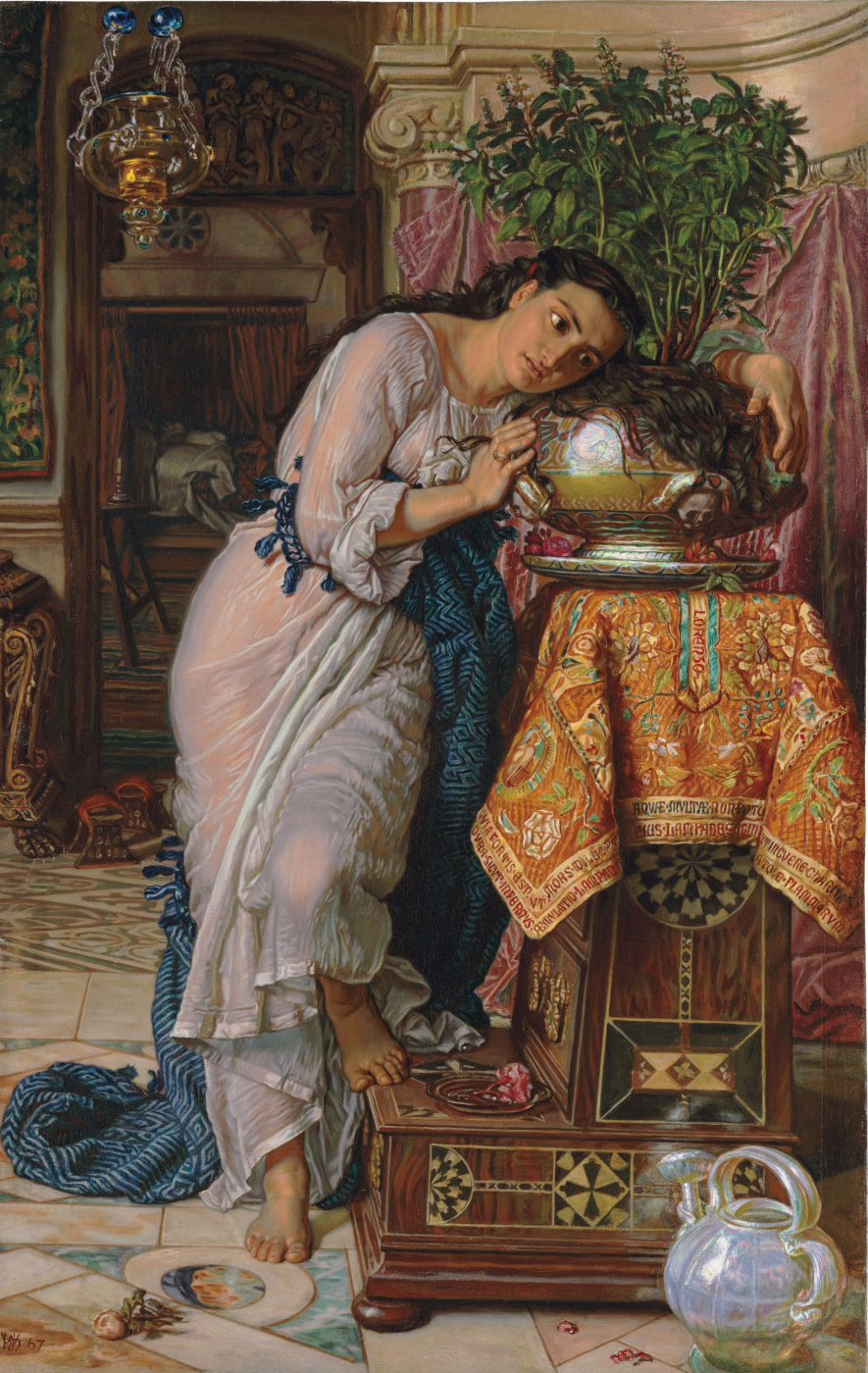Isabella and the pot of basil
Description of the artwork «Isabella and the pot of basil»
This picture does not belong to any list of “the fateful works of art of all times”. Perhaps, it should.
... A beautiful young woman bents over a flower pot with a basil — this is what the name of one of the most famous works by the Pre-Raphaelite artist William Hunt says. The action takes place in a lush, richly decorated room. The subject doesnot suppose any breakdown or tragedy. It’s just curious what the girl seems to be listening to when embracing (or even, as they sometimes write, caressing) an intricately decorated ceramic pot, what are her thoughts about, or whom? And what does the plant itself have to do with it?
The stucco moulding on the pot provides a partial clue to what is happening, it is an unambiguous hint from the artist. Do you see the skulls? Well, it is time to summarize the content of the Keats’ poem, which is based on one of the novellas from Boccaccio’s Decameron, a collection of love-adventure stories that had been published in 1351—1352.
So, once upon a time there lived a beautiful girl in Florence, whom her brothers wanted to marry off to a wealthy man, the owner of olive plantations. And she suddenly fell in love with Lorenzo, a simple hired worker who carried out the brothers’ instructions: the democratic joint family meals in the company with the clerk played their fatal role. The matter was not limited to platonic dreams. One day one of the brothers found Isabella walking into the young man’s room at night. It was decided to hide the sin of adultery in the most radical way — to kill Lorenzo. That was done, and the brothers told Isabella that the worker was “on a business trip”, as though they sent him out of town with some order. Well, he never returned... However, he appeared to his beloved as a ghost and told her about the crime, describing the details thanks to which Isabella found the grave of her beloved. Furthermore…
Do you remember the fairy tale by Hans Christian Andersen “The Elf of the Rose”, which is partly retelling the same plot? Distraught with grief, the young woman digs up the body and cuts off Lorenzo’s head.
In anxious secrecy they took it home,
And then the prize was all for Isabel:
She calm’d its wild hair with a golden comb,
And all around each eye’s sepulchral cell
Pointed each fringed lash; the smeared loam
With tears, as chilly as a dripping well,
She drench’d away:—and still she comb’d, and kept
Sighing all day—and still she kiss’d, and wept.
Then in a silken scarf,—sweet with the dews
Of precious flowers pluck’d in Araby,
And divine liquids come with odorous ooze
Through the cold serpent pipe refreshfully, She wrapp’d it up;
and for its tomb did choose
A garden-pot, wherein she laid it by,
And cover’d it with mould, and o’er it set
Sweet Basil, which her tears kept ever wet.
Unfortunately the brothers found out everything, took away the burial pot, and Isabella soon died. This is a sad story. It also played a cruel joke with the artist himself, who depicted so skilfully the abode of the lost love and the heroine of the poem, beautiful in her sorrow.
The master conceived the picture in 1848, and he made a number of sketches. Although, as they say, he was captivated by the exciting eroticism of the Decameron novella, the focus on the image of the main character was not made immediately. The sketches depicted both treacherous brothers checking accounts and Lorenzo at work.
Almost 18 years have passed. The artist got married, and together with the pregnant Fanny Waugh set off on a trip to Italy. An idyll! Wonderful nature, beloved beautiful wife... It was time to create a picture that would be based on the long-drawn plot, this time depicting only the wonderful, albeit inconsolable Isabella. Was that a good idea? Fate was merciless to the artist: there, in Italy, in 1866, shortly after giving birth, Fanny died of a fever. The grieving artist transferred the features of his departed wife to the canvas...
He finished the painting in 1868, already in England. The detailed and exciting work of the artist was highly appreciated by his colleagues: other Pre-Raphaelites, Waterhouse and Alexander, depicted their own “Isabellas...” after Hunt. But the Pre-Raphaelites did not accept the Hunt’s marriage to Edith, Fanny’s sister (this action was completely illegal in England, therefore the couple left for Switzerland), a conflict broke out: the relationship between the “sisters” and “brothers” was always difficult. And the picture continued to be haunted by a train of bad luck, although at first it had been bought and presented to the public by Ernest Gambaro himself, a famous art dealer, kind of Larry Gagosian of England of that time.
The canonical work of one of the founders of the glorious commonwealth was sold in 2014 at Christie’s for $ 4.25 million. This seemingly worthy result was far from the initial auction estimate of such an outstanding canvas (8.4—13.4 million dollars), as well as from the hopes of the Delaware Art Museum (USA, Delaware Art Museum) to solve the financial problems of the institution at this expense. The painting has been kept there since 1947. They said that the demand for the art by the Pre-Raphaelites was on the decline, therefore the museum workers had lowered the starting price and eventually bailed out a good amount. It was a world cost record set for William Hunt’s paintings. But since then Isabella and the Pot of Basil has entered an unknown private collection.
Author: Olha Potekhina
Note: the poetic excerpt is taken from the Keats’ poem


